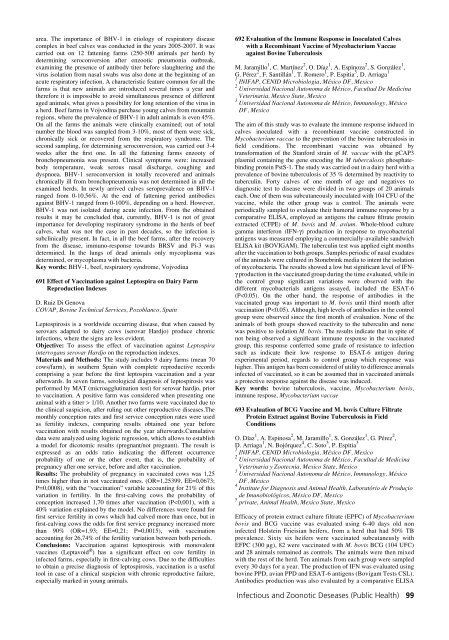Oral and Poster Abstracts
Oral and Poster Abstracts
Oral and Poster Abstracts
Create successful ePaper yourself
Turn your PDF publications into a flip-book with our unique Google optimized e-Paper software.
area. The importance of BHV-1 in etiology of respiratory disease<br />
complex in beef calves was conducted in the years 2005-2007. It was<br />
carried out on 12 fattening farms (250-500 animals per herd) by<br />
determining seroconversion after enzootic pneumonia outbreak,<br />
examining the presence of antibody titer before slaughtering <strong>and</strong> the<br />
virus isolation from nasal swabs was also done at the beginning of an<br />
acute respiratory infection. A characteristic feature common for all the<br />
farms is that new animals are introduced several times a year <strong>and</strong><br />
therefore it is impossible to avoid simultaneous presence of different<br />
aged animals, what gives a possibility for long retention of the virus in<br />
a herd. Beef farms in Vojvodina purchase young calves from mountain<br />
regions, where the prevalence of BHV-1 in adult animals is even 45%.<br />
On all the farms the animals were clinically examined; out of total<br />
number the blood was sampled from 3-10%, most of them were sick,<br />
chronically sick or recovered from the respiratory syndrome. The<br />
second sampling, for determining seroconversion, was carried out 3-4<br />
weeks after the first one. In all the fattening farms enzooty of<br />
bronchopneumonia was present. Clinical symptoms were: increased<br />
body temperature, weak serous nasal discharge, coughing <strong>and</strong><br />
dyspnoea. BHV-1 seroconversion in totally recovered <strong>and</strong> animals<br />
chronically ill from bronchopneumonia was not determined in all the<br />
examined herds. In newly arrived calves seroprevalence on BHV-1<br />
ranged from 0-10.56%. At the end of fattening period antibodies<br />
against BHV-1 ranged from 0-100%, depending on a herd. However,<br />
BHV-1 was not isolated during acute infection. From the obtained<br />
results it may be concluded that, currently, BHV-1 is not of great<br />
importance for developing respiratory syndrome in the herds of beef<br />
calves, what was not the case in past decades, so the infection is<br />
subclinically present. In fact, in all the beef farms, after the recovery<br />
from the disease, immuno-response towards BRSV <strong>and</strong> Pi-3 was<br />
determined. In the lungs of dead animals only mycoplasma was<br />
determined, or mycoplasma with bacteria.<br />
Key words: BHV-1, beef, respiratory syndrome, Vojvodina<br />
691 Effect of Vaccination against Leptospira on Dairy Farm<br />
Reproduction Indexes<br />
D. Ruiz Di Genova<br />
COVAP, Bovine Technical Services, Pozoblanco, Spain<br />
Leptospirosis is a worldwide occurring disease, that when caused by<br />
serovars adapted to dairy cows (serovar Hardjo) produce chronic<br />
infections, where the signs are less evident.<br />
Objective: To assess the effect of vaccination against Leptospira<br />
interrogans serovar Hardjo on the reproduction indexes.<br />
Materials <strong>and</strong> Methods: The study includes 9 dairy farms (mean 70<br />
cows/farm), in southern Spain with complete reproductive records<br />
comprising a year before the first leptospira vaccination <strong>and</strong> a year<br />
afterwards. In seven farms, serological diagnosis of leptospirosis was<br />
performed by MAT (microagglutination test) for serovar hardjo, prior<br />
to vaccination. A positive farm was considered when presenting one<br />
animal with a titter > 1/10. Another two farms were vaccinated due to<br />
the clinical suspicion, after ruling out other reproductive diseases.The<br />
monthly conception rates <strong>and</strong> first service conception rates were used<br />
as fertility indexes, comparing results obtained one year before<br />
vaccination with results obtained on the year afterwards.Cumulative<br />
data were analyzed using logistic regression, which allows to establish<br />
a model for dicotomic results (pregnant/not pregnant). The result is<br />
expressed as an odds ratio indicating the different occurrence<br />
probability of one or the other event, that is, the probability of<br />
pregnancy after one service, before <strong>and</strong> after vaccination.<br />
Results: The probability of pregnancy in vaccinated cows was 1,25<br />
times higher than in not vaccinated ones. (OR=1,25399, EE=0,0673;<br />
P=0,0008), with the “vaccination” variable accounting for 21% of this<br />
variation in fertility. In the first-calving cows the probability of<br />
conception increased 1,70 times after vaccination (P

















